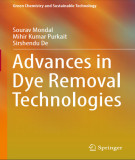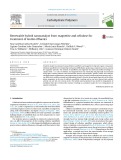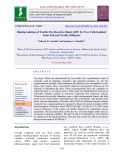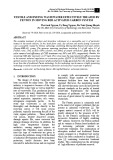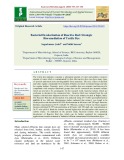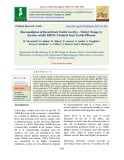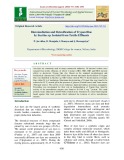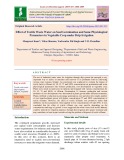
Textile effluent
-
Ebook "Advances in dye removal technologies" describes the various advanced treatment methods for removal of multiple types of dyes from effluent stream. It pays particular attention to the economic aspects of treatment of textile waste-water. The different technologies illustrated in the book include adsorption, nanofiltration, advanced oxidation, micellar enhanced ultrafiltration, cloud-point extraction, and electrocoagulation.
 350p
350p  lamquandat
lamquandat
 28-12-2023
28-12-2023
 3
3
 2
2
 Download
Download
-
A hybrid catalyst was prepared using cellulose nanofibrils and magnetite to degrade organic compounds. Cellulose nanofibrils were isolated by mechanical defibrillation producing a suspension used as a matrix for magnetite particles.
 7p
7p  vihermione
vihermione
 06-01-2023
06-01-2023
 12
12
 2
2
 Download
Download
-
The present study deals with the degradation of Reactive black GDN by different bacterial cultures isolated from a contaminated site. Amongst 5 cultures, the isolate 4 displayed 96% decolourisation of Reactive black GDN (100 mgl-1 ) in 24h to 72 h. The colour removal efficiency of the isolate was further improved by optimizing various parameters. The decolourisation of the dye was 1.9 times higher under static as compared to shaking condition. The pH 7.0 and 37oC temperature were found to be optimum for the decolourisation of the dye.
 13p
13p  trinhthamhodang11
trinhthamhodang11
 27-04-2021
27-04-2021
 16
16
 1
1
 Download
Download
-
In the present study, effluent samples were collected from various textile and dyeing industries located in and around Vellore District, Tamilnadu, India and were exploited for the screening and isolation of bacterial strains that were capable of decolorizing Congo red. Optimization of cultural conditions was carried out to maximize decolorization efficiency of the bacterial isolate TVU-CR4 towards Congo red.
 10p
10p  caygaocaolon11
caygaocaolon11
 21-04-2021
21-04-2021
 15
15
 1
1
 Download
Download
-
Water is considered to be one of the essential resources for the survival of living beings. The vital resource is exposed to toxic pollutant due to the untreated industrial discharge from tannery, textile and other industries. Effluents discharged from the tannery and textile industries contains an ample of heavy metals and other toxic azo dyes which affects the living beings including aquatic and terrestrial flora and fauna. The removal of this toxic compounds from the water bodies has become a challenge to the human society.
 9p
9p  caygaocaolon11
caygaocaolon11
 21-04-2021
21-04-2021
 23
23
 1
1
 Download
Download
-
The complete treatment of colors and hazardous substances at a reasonable cost is of particular interest in the textile industry. In this batch form study, dye solution and textile dyeing wastewater were successfully treated by Fenton technology combining Moving Bed Reactor/Activated carbon (Fenton-MBR/AC) system. The optimum operating conditions including 3.5 of pH value, 0.5 of Fe/H2O2 ratio, 25mL of H2O2 (30%) solution, and 200mL of sample were found. After 60 min, the color removal and efficiency of COD treatment was 94% and 89%, respectively.
 4p
4p  caygaocaolon11
caygaocaolon11
 18-04-2021
18-04-2021
 15
15
 1
1
 Download
Download
-
Present experiment formulated to study bacterial decolourization of Red HE7B dye with identification and molecular characterization by RAPD.
 7p
7p  gaocaolon9
gaocaolon9
 22-12-2020
22-12-2020
 7
7
 2
2
 Download
Download
-
Increasing industrialization and urbanization result in the discharge of waste to the environment, which in turn creates more pollution. Environmental biotechnology is constantly expanding its efforts in the biological treatment of colored textile effluents, which is an environmental friendly and low cost alternative to physico-chemical decomposition processes.
 8p
8p  angicungduoc6
angicungduoc6
 20-07-2020
20-07-2020
 11
11
 1
1
 Download
Download
-
Environmental pollution has been recognized as one of the major problems of the modern world. The increasing demand for water and the dwindling supply has made the treatment and reuse of industrial effluents as an attractive option. Halophilic bacterial isolates, TVU-AO6 and TVU-AO4 were found to be the efficient strains exhibiting maximum decolorization efficiency towards Acid Orange and they were selected for the development of consortium TVU-AO 64.
 8p
8p  nguaconbaynhay6
nguaconbaynhay6
 23-06-2020
23-06-2020
 10
10
 0
0
 Download
Download
-
Ultrafiltration membrane was used to treat the effluent from textile industries. Crossflow ultrafiltration using GN polymeric membrane was used to remove the dye from textile effluent. A synthetic textile effluent of Direct-15 dye was used. The study focused through the effect of feed concentration, transmembrane pressure and solution’s pH on the permeate flux and percentage of dye removal were investigated. Dye concentration had significant effects on flux values. Under the fixed pressures and pH, the flux decreased while the dye rejection increased with increasing feed concentration.
 10p
10p  12120609
12120609
 01-06-2020
01-06-2020
 15
15
 0
0
 Download
Download
-
The textile dye industries consume a substantial amount of water and produce extensive amount of waste which is contaminated by dyes like reactive dyes, azo dyes, many types of aerosols and much more non-degradable waste materials. The toxic effects of dyestuff and other organic compounds from modern effluents are harsh on human beings and also for regular habitat. Currently, most of the available dyes are aromatic and heterocyclic compounds with complex functional groups that can be converted into aromatic amines which are proved to be carcinogenic.
 10p
10p  trinhthamhodang1213
trinhthamhodang1213
 29-05-2020
29-05-2020
 15
15
 0
0
 Download
Download
-
Textile effluent samples collected from dye contaminated area of Ranipet, Vellore have been used for isolating bacterial strains. Among various bacterial isolates, BRTSI-3 was selected and was further characterized using morphological and biochemical analysis. 16S rDNA sequencing confirmed the strain BRTSI3 as Bacillus subtilis (NCBI accession number MH412808). The culture conditions for maximizing bacterial biomass were found to be optimized at 35oC and pH 8.0. Bacillus subtilis effectively decolorized methyl orange in nutrient broth within 48 h of incubation.
 7p
7p  trinhthamhodang5
trinhthamhodang5
 16-05-2020
16-05-2020
 20
20
 2
2
 Download
Download
-
Azo dyes are commonly used in many commercial industries. 16 bacterial isolates were isolated from textile effluents, of which 4 isolates (HB1, HB2, HB3 and HB4) showed ability to decolorize Trypan blue dye. Based on the standard morphological and biochemical characteristics, HB3 isolate that showed maximum decolorization of Trypan blue was identified as Bacillus sp. HB3 isolate showed 96.6 % decolorization of Trypan blue within 24 h of incubation.
 11p
11p  trinhthamhodang5
trinhthamhodang5
 16-05-2020
16-05-2020
 8
8
 0
0
 Download
Download
-
In this study, the effluent wastewater samples collected from dyestuff industrial area have been examined for biological treatment. The rate of decolorization was assessed using spectrophotometer at 508 nm and the percentage of decolorization was ascertained. The metabolites of Direct Red 81 (DR81) obtained after biodegradation were determined by HPLC. In order to improve the decolorization process, the effect of process factors like pH, temperature, agitation and dye wastewater concentration on dye decolorization was studied.
 18p
18p  angicungduoc4
angicungduoc4
 26-04-2020
26-04-2020
 18
18
 0
0
 Download
Download
-
The use of industrial waste water for irrigation through drip system has emerged a very important way to utilize its nutrients and removal of its pollutants load by cultivating various crops (tomato, brinjal). An experiment was conducted to evaluate the impact of textile factory effluents (0, 10, 35, 75 and 100% concentration) on germination and some physiological parameters like biomass production, root development in vegetable crop. Plants were raised in small pots in triplicate and irrigated with various concentrations (0, 10, 35, 75 and 100%) of effluent.
 4p
4p  trinhthamhodang3
trinhthamhodang3
 22-02-2020
22-02-2020
 17
17
 0
0
 Download
Download
-
Water is a essential source, nowadays days the resources of the water and its availability is lacking. Industrial pollutions like textiles, leather, food industries, pharmaceuticals are the major part of pollutants and creating a major problems. Especially textile areas, uses high colorant synthetic chemical dyes, and also recalcitrant, mutagenic in nature.
 5p
5p  chauchaungayxua3
chauchaungayxua3
 07-02-2020
07-02-2020
 5
5
 0
0
 Download
Download
-
The aim of the study was to isolate and identify the salt tolerant growth promoting bacteria from rhizosphere soil of Sesuvium portulacastrum and also from the soils of dye and textile effluent contaminated sites (Andipalayam, Orathupalayam, Mangalam and Palayakottai villages of Tirupur District, Tamil Nadu) to remediate the salt contaminated soil. On total twenty five strains were selected based on the distinct morphological characters on R2A agar medium supplemented with 3 % NaCl.
 12p
12p  quenchua2
quenchua2
 15-12-2019
15-12-2019
 19
19
 0
0
 Download
Download
-
Isolation and identification of the bacteria from textile effluent and evaluation of their ability to decolorize toxic sulfonated azo dye, Direct Red 81 were studied. A total of four bacterial strains were isolated from textile wastewater and their decolorizing activity was measured spectrophotometrically after incubation of the isolates for 24 h. in mineral salt medium modified with 100 ppm Direct Red 81 and supplemented with yeast extract. The bacterial strains were identified belonging to Raoultella planticola strain ALK314 (DR1), Klebsiella sp.
 13p
13p  kethamoi2
kethamoi2
 15-12-2019
15-12-2019
 42
42
 0
0
 Download
Download
-
Nowadays, synthetic dyes are widely used in textile, leather, cosmetics, paper, food and pharmaceutical industries instead of natural dyes due to its availability, stability, low cost and color intensity which emerges a new problem of residual color in the discharged effluent. Improper discharge of dye effluent in aqueous ecosystems is aesthetically unpleasant and impedes photosynthetic activity reducing sunlight penetration, dissolved oxygen concentration and water quality in total.
 9p
9p  cothumenhmong1
cothumenhmong1
 11-12-2019
11-12-2019
 23
23
 0
0
 Download
Download
-
Hydroxyapatite/titania nanocomposites (TiHAp) were synthesized from a mixture of a titanium alkoxide solution and dissolution products of a Moroccan natural phosphate. The simultaneous gelation and precipitation processes occurring at room temperature led to the formation of TiHAp nanocomposites. X-ray diffraction results indicated that hydroxyapatite and anatase (TiO2) were the major crystalline phases. The specific surface area of the nanocomposites increased with the TiO2 content. Resulting TiHAp powders were assessed for the removal of the patent blue V dye from water.
 9p
9p  kequaidan1
kequaidan1
 16-11-2019
16-11-2019
 14
14
 2
2
 Download
Download
CHỦ ĐỀ BẠN MUỐN TÌM








